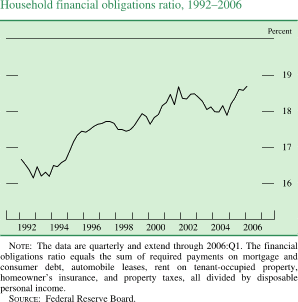He didn't bother to explain how it is, 33 years later, that we're able to afford much larger homes with all sorts of upgrades our parents never dreamed of. He also didn't explain how it is that we have more cars, appliances, vacations, recreation vehicles, clothing, meals out, wealth etc. then we did in 1973. I guess all that wealth is just a figment of our imagination since the real median incomes of male workers hasn't increased since 1973.Like me, Reynolds believes that real consumption per capita is a better measure of our increased living standards. Since 1973, he says our real consumption per capita has doubled. How can it double if our real per-capita wages aren't increasing?
Hmm, that certainly is a puzzle.
The personal savings rate in 1973 was 10.5%; in 2004, the rate was 1.2%. (Bureau of Economic Analysis, Department of Commerce.)
"If there's a bubble, it's in this four-letter word: Debt," said Merrill Lynch chief North American economist Dave Rosenberg.
The number of personal bankruptcy filings in the fiscal year ended Sept. 30, 2003, rose 7.8% from the same period in 2002, reaching 1,625,813, according to the American Bankruptcy Institute (ABI). That’s twice the number of people filing for personal bankruptcy protection in 1993.
About 43% of U.S. families spend more than they earn, according to a Federal Reserve study.
More than 1 million homeowners now have three or more mortgages on their property. Meantime, over 1.8 million owners have outstanding loans that equal 100% or more the value of their homes.
http://moneycentral.msn.com/content/SavingandDebt/P70741.asp
Perhaps the answer is that our individual value to the economy is no longer in what we produce, but in what we consume. We have more because we borrow more.
Keep singing Don't Worry, Be Happy as we circle the drain.
The personal savings rate in 1973 was 10.5%; in 2004, the rate was 1.2%.The savings rate doesn't include home equity or unrealized capital gains. When you realize capital gains, they are ignored but the capital gains tax paid is subtracted from savings. Not the most useful stat the Feds publish.
We have more because we borrow more.
And yet our net worth, assets minus liabilities, is higher than ever.
Keep singing Don't Worry, Be Happy as we circle the drain.
Math is hard.
We have more because we borrow more. We're mired in debt. Is that it? If so, you'd expect our debt to income ratio to be skyrocketing.

Wow! With interest rates at historic lows (You'd expect people to borrow more when rates are low, wouldn't you?)our debt to income ratio hasn't gone up even 1% over the past decade. You've got to work pretty hard to continuously ignore these facts and constantly see doom.
